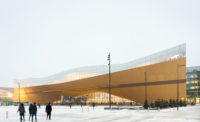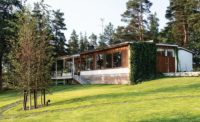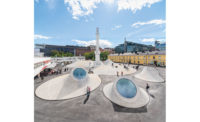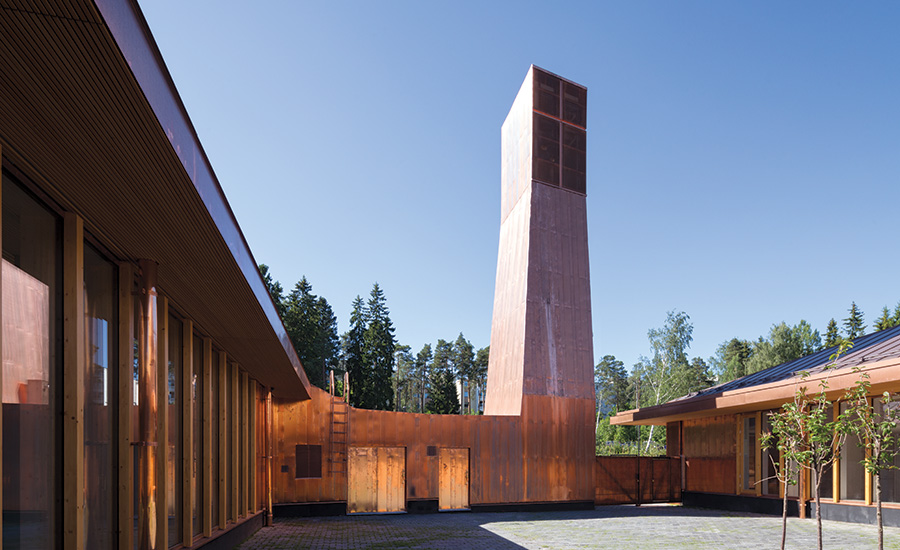Suvela Chapel by OOPEAA
Espoo, Finland

The dramatically pitched–roof form of the worship hall is clad entirely in copper.
Photo © Marc Goodwin

The building’s site, adjacent to a park, encouraged the inclusion of a kindergarten and teen center.
Photo © Marc Goodwin

The interior courtyard facades are glazed structures of glue-laminated wood columns.
Photo © Marc Goodwin

The dramatically pitched–roof form of the worship hall has a sculptural and symbolic character.
Photo © Mika Huisman

The pyramidal form of the spruce-slatted worship hall is topped with a large window that directs daylight into the warm and tactile interior.
Photo © Marc Goodwin

In the other interior spaces, an outer layer encases a sequence of rooms for entrance, orientation, movement, and meeting.
Photo © Marc Goodwin

Image courtesy OOPEAA

Image courtesy OOPEAA








Architects & Firms
In the the darkening late-autumn twilight of Suvela, a Helsinki suburb, a young Chinese couple steps down from the bus at the neighborhood stop, returning home from their research day at the nearby Aalto University. Three Somali youths kick a soccer ball down the sidewalk, courteously allowing a hijab-adorned mother to push along a stroller. Behind them, inside the angled, prow-like form of the copper-striated, softly glowing Suvela Chapel, parishioners engage in spirited discussion with their pastors under the high, canted, and spruce-paneled surfaces of the worship hall. Across the chapel’s interior cobblestoned courtyard, children of all backgrounds laugh, draw, paint, and perform throughout a series of colorful classrooms, each opening onto a playground and the adjacent park.
Additional Information:Jump to credits & specifications
“What is a church supposed to look like?” asks OOPEAA principal Anssi Lassila. “There is no prototypical way of making a Finnish church. For us, it is a meeting place—a community center more than a place of worship.” Lassila’s assertions bear weight, coming after OOPEAA’s completion of four significant and highly regarded Lutheran parish churches throughout Finland in the last 15 years, a sequence now punctuated by the September 2016 dedication of the Suvela Chapel, a parish center already a finalist for the Finlandia Prize, the country’s highest architectural honor.
Despite the open-ended nature of Lassila’s question, the parish center provides an intense statement of OOPEAA’s design approach: careful understanding of context, of purpose, and of construction—along with a keen sense of traditional Finnish typologies—intertwine to inform elegant design decisions.
Suvela is a rapidly growing district in the Helsinki municipality of Espoo, 9 miles west of the city center. While Espoo contains Tapiola, the quintessential “city in the forest” of ambitious post–World War II planning efforts, Suvela’s peripheral architectural and urban character is more prosaic: mainly six- to eight-story housing blocks, constructed of blandly colored prefabricated-concrete panels, spaced judiciously amid the wooded terrain. Socially, the area reflects the increasing multiculturalism of Finland’s capital region, with roughly one-third of its inhabitants being of foreign descent. By 2010, the growth led the parish to consider building a new church. A prominent street corner site adjacent to a park made civic needs—a teen center and a kindergarten— a further incentive. The project, paid for by the church and supplemented by rental income from the city, expanded for these combined sacred and secular purposes. “Context” in this built environment included recognition of the community to be served, diverse in background, age group, and need.
The courtyard typology OOPEAA employs is the Finnish vernacular of farm-building complexes, though also visible in more modern religious and civic structures—think of Alvar Aalto’s 1952 Säynätsalo Town Hall. But the intelligent ordering of program into a visible U-plan type here is triply site-specific. It produces a definite boundary that addresses the activity and noise of the street corner and park; an enclosed courtyard for general entrance from the parking lots and for community gathering in good weather; and, lastly, a recognizable “head to tail” sequence in the plan, where the larger volume of the worship hall is accorded civic presence on the public corner, and the smaller-scaled program elements—offices, meeting rooms, classrooms, and service areas—are tightly arrayed as the enclosing limbs of the courtyard.
The courtyard organization also establishes an outer layer of public rooms and offices, sheathed in vertical copper panels and punctuated by window apertures specific to each room and orientation, with inflected expanses of wood panels inset by entrances. An inner layer of spaces for entrance, circulation, and meeting forms a territory known as an aula in Finnish.
If the courtyard plan responds on several levels to the context, so does the design, with its parallel sectional qualities of volumetric variation, controlled scale, and admission of daylight, all attentive to the surroundings and ambitions of a project with both religious and civic significance, and their technical requirements. Rising above the courtyard, the dramatically pitched–roof forms of the worship hall and children’s learning center possess both sculptural and symbolic character, but their angled volumes also enclose the air-handling units and frame skylights that draw and direct natural light into these spaces.
OOPEAA’s multiple commissions demonstrate a strong commitment to building well in the harsh Finnish climate, with distinct material quality, and within budgetary and other constraints. Copper was selected for its long, maintenance-free lifespan and its ability to clad an entire exterior, both walls and roof. The hybrid framing structure combines reinforced-concrete bearing walls and steel framing elements, mounted with extensive wood trusswork undergirding the roof forms. The three-dimensional variations of copper panels resulted from a digital analysis of the building’s surfaces, correlated to the maximum dimensions of standard copper sheeting. The eventual green patina over the untreated surface is seen by the architect as a desirable sign of age.
A similarly unifying palette was used on the interior, where surfaces are covered in spruce-slatted panels. In the worship hall, beyond the warmth and tactility of the spruce wall and ceiling, is a wealth of detail: softly rounded oak door handles in brass fittings, fritted glass wall panels inscribed with biblical verses in multiple languages, and custom chairs fabricated with the designer Mikko Paakkanen in keeping with a Nordic tradition. The layered glass screen wall behind the altar and baptismal font, vibrantly striated by the color spectrum, is the work of artist Hannu Konola.
In Finland, such commissions are usually awarded through an open competition, but OOPEAA was selected as part of an architect/contractor bid. That led the architects into direct engagement with the community, in a series of searching conversations over many months. Notably, this resulted in a one-story rather than multistory building, to create a welcoming and accessible space.
Suvela Chapel’s fitting of form to purpose and its attention to design fundamentals achieve a dignified urban presence. The engaged process of its making, while less visible or material, is perhaps equally substantial: the built work has activated both the sacred and secular life of that community. To paraphrase the architect: in Finland, what else should a church be?
CreditsArchitect: OOPEAA (Office for Peripheral
Pöyry Finland (structural, fire); Geotek (geotechnical); Ramboll Finland (electrical)
Akukon (acoustics); Wise Group (HVAC)
YIT Rakennus
|
SpecificationsCopper cladding and window frames: Porvoon Vaskisepät
Taskisen Puu
Nikari
Secto, Glasshütte Limburg |














